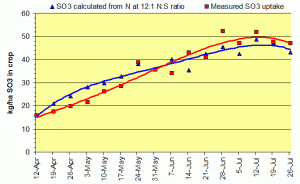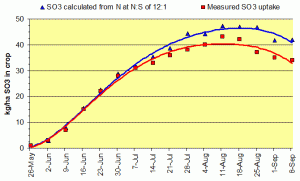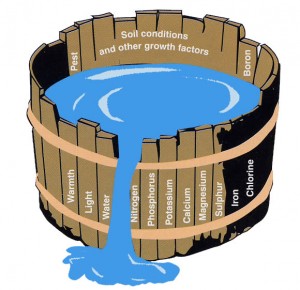Download pdf: Balanced nutrition shown by nitrogen:sulphur ratios (234.62K)
pdf 234.62K
Balanced nutrition shown by nitrogen:sulphur ratios
November 2011

In a recent Newsletter the pattern of uptake of potassium and some other nutrients during the growing season was shown. The same French data-set also analysed the crops for the patterns of nitrogen (N) and sulphur (S) uptakes. The majority of the N and S in crops (other than the Brassicae, such as oilseed rape, cabbage, kale etc) is in combination in proteins, and as with most animal proteins the ratio of N to S (N:S) in plants is fairly consistently around 12:1. This close relationship between N and S can be illustrated using this data-set of crop uptake. In the figures the accumulation over the season of sulphur (as SO3) is shown by the red lines in the two charts, for wheat and potatoes. The two blue lines indicate an SO3 content which has been calculated from the measured N content, assuming a 12:1 N:S ratio. This would mean that for every 12 kg of N in the crop it would also contain 1 kg of S, or 2.5 kg of SO3. The fact that the blue and red lines are well aligned supports the principle that the S requirement of these crops is closely related to their need for N. It is likely that the necessary S requirement can be predicted for many crops as being approximately one twelfth of their N requirement. This concept would still apply in principle to legumes, although the amount of ‘applied’ N is not known! Clearly brassicas have a much greater sulphur requirement due to the non-protein glucosinolates which contain S, and thus have a closer N:S ratio.

This discussion may not seem relevant to a potash-focussed newsletter – although sulphate of potash is a useful source of S – but it is a valuable illustration of the relationships between nutrients which exists in plants. If the crop, arable or grass, cannot find an adequate balance of all the nutrients it needs it will not perform to its potential – a fact well illustrated by Liebig and his barrel. We are fortunate that some of the major nutrients, such as potash, phosphate, magnesium and calcium, can be safely stored in agricultural soils so that they can supply the plant needs as they develop. The adequacy of this store is checked by soil analysis, and removals at harvest can be readily replaced using manures and fertilisers. Nutrients such as nitrogen, and the mathematically related sulphur, require more skilful management. If for example too little is applied the crop is unlikely to achieve its potential, and if too much then unwanted losses can occur. It is important that the care devoted to the management of nitrogen does not ‘drown out’ the equally important but much simpler management of those nutrients which are well buffered in the secure soil store. No single nutrient can claim to be more important than others, although some may be more difficult to manage; all essential nutrients are just that: essential. The image of Liebig’s barrel is a useful reminder.


